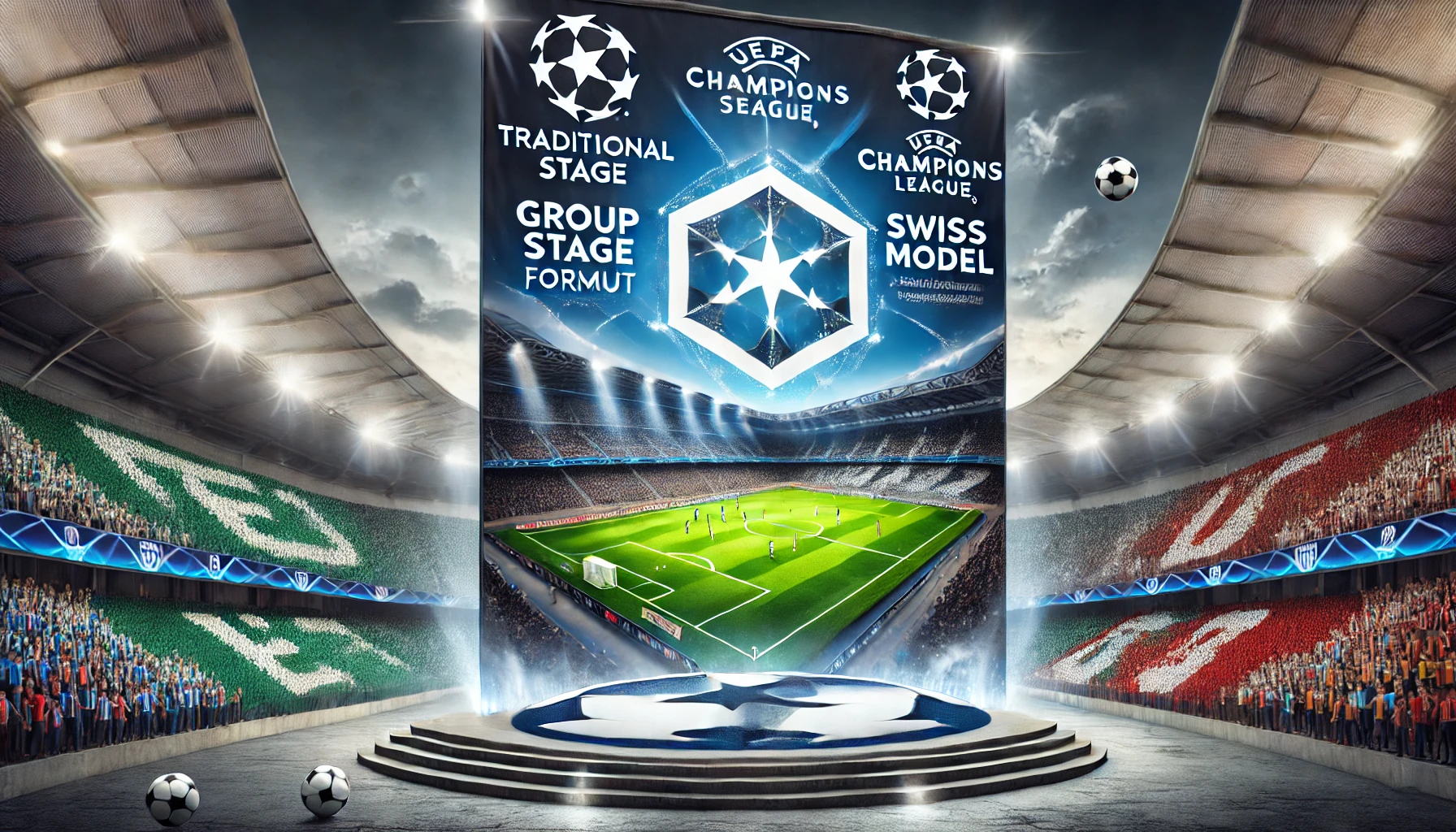UEFA Champions League Swiss Model: How the New Champions League Format Works
UEFA Champions League Swiss Model: The UEFA Champions League is set to undergo one of its most significant format changes in decades, adopting the Swiss model starting from the 2024 season. This shift has generated considerable interest among football fans and analysts alike, as it promises to alter the competition’s structure in ways that could profoundly impact how teams approach the tournament. In this blog, we’ll dive into what the Swiss model is, how it works in the context of the Champions League, and why UEFA decided to implement this new format. We’ll also explore the advantages of the Swiss model in sports and compare it to traditional formats like the round-robin.
What is the Swiss Model Champions League Format?
The Swiss model, traditionally used in chess and other tournament settings, is a competition format designed to offer a balanced and fair way to rank participants. It ensures that teams play against opponents of similar strength throughout the tournament, which keeps the competition engaging and competitive. In the context of the Champions League, the Swiss model will replace the familiar group stage with a single league table that includes all participating teams.
How the Swiss Model Works in the Champions League
Under the new Swiss model format, each team will play a set number of matches against different opponents, instead of playing home and away games within a small group. Here’s how it works:
- Single League Table: All participating teams are placed into a single league table. However, instead of playing against every other team, each team will play a predetermined number of matches (likely 10 games) against opponents drawn from different tiers based on their ranking.
- Randomized Opponents: The draw will determine the matchups, ensuring that teams face a variety of opponents across the competition. The matches are designed to pit stronger teams against one another, while also giving lower-ranked teams a chance to compete without being overwhelmed.
- Qualification: The top teams from the league table will automatically qualify for the knockout stage. Additionally, teams that finish just outside the automatic qualification spots may enter a playoff to secure their place in the next round.
This system is intended to provide a more balanced and competitive tournament while reducing the predictability of the group stage.
Champions League Swiss Model Explained: Why the Change?
UEFA’s decision to adopt the Swiss model in the Champions League stems from a desire to increase the number of high-stakes, competitive matches throughout the tournament. The traditional group stage, while familiar, often led to predictable outcomes, with stronger teams easily advancing to the knockout stages and weaker teams being eliminated early on.
Advantages of the Swiss Model in the Champions League
The Swiss model offers several benefits that make it an attractive option for a tournament as prestigious as the Champions League:
- Increased Competitiveness: By ensuring that teams face opponents of similar strength, the Swiss model keeps more teams in contention for longer, making the group stage less predictable and more exciting.
- More Matches: The new format guarantees that each team will play at least 10 matches, compared to the 6 matches in the previous group stage format. This increase in the number of games is beneficial for fans, broadcasters, and sponsors alike.
- Fairer Qualification: The league table format means that teams are ranked based on their overall performance across multiple matches, reducing the impact of a single bad game. This could lead to a more deserving set of teams advancing to the knockout stages.
How Does the Swiss Model Work in the Champions League?
Understanding the intricacies of the Swiss model can be challenging, especially for fans accustomed to the traditional group stage format. Here’s a breakdown of how this model will function in practice:
- Match Selection: Teams will not play against every other team in the league table. Instead, they will be drawn to play against a selection of opponents based on a tiered system that takes into account their ranking and previous performance.
- Point Accumulation: Teams will earn points for each match (typically 3 points for a win, 1 point for a draw, and 0 for a loss), which will determine their position in the league table. The higher a team finishes in the table, the better their chances of advancing to the knockout stage.
- Knockout Qualification: The top 8 teams in the league table will automatically qualify for the knockout stage. Teams finishing 9th to 24th will enter a playoff round, where they will compete for the remaining knockout spots.
This structure is designed to maintain excitement and competition throughout the tournament, as teams will have to consistently perform well to secure their place in the later stages.
UEFA Champions League New Format: What to Expect in 2024
The 2024 season will mark the debut of the Swiss model in the UEFA Champions League. This change is part of a broader restructuring of European football, aimed at keeping the competition fresh and engaging for fans.
Key Changes in the 2024 UEFA Champions League Structure
- Expanded Competition: The number of teams participating in the Champions League will increase, with more clubs from different countries getting the chance to compete at the highest level. This expansion is intended to make the tournament more inclusive and competitive.
- More High-Stakes Matches: The new format ensures that there will be more matches between top teams during the league stage, which should attract higher viewership and generate more interest in the competition.
- Playoff Round: The introduction of a playoff round for teams finishing just outside the top 8 adds another layer of excitement to the competition. This round will give more teams a chance to progress, keeping the tournament competitive until the very end.
These changes reflect UEFA’s commitment to maintaining the Champions League as the premier club competition in world football, offering fans more thrilling matches and storylines to follow.
Swiss Model vs Round-robin: Comparing Tournament Formats
The introduction of the Swiss model in the Champions League has led to comparisons with the traditional round-robin format used in most football tournaments. Each format has its own strengths and weaknesses, which are important to consider when evaluating the impact of this change.
Swiss Model in Football: A New Era of Competition
- Balanced Matchups: One of the primary advantages of the Swiss model is its ability to create balanced matchups. By ensuring that teams of similar strength play against each other, the competition remains intense and unpredictable.
- Increased Viewer Engagement: The Swiss model’s focus on competitive balance means that every match is crucial, keeping viewers engaged throughout the tournament. This contrasts with the round-robin format, where some matches can become dead rubber games with little at stake.
Round-robin: A Tried-and-True Format
- Familiarity: The round-robin format is well-known and easy to understand, making it accessible to all fans. Each team plays against all others in its group, with the top teams advancing to the next stage.
- Comprehensive Competition: The round-robin format ensures that every team faces the same opponents, providing a comprehensive test of their abilities. However, this can also lead to predictable outcomes, particularly in groups with a significant disparity in team strength.
The choice between the Swiss model and round-robin ultimately depends on the goals of the competition organizers. While the round-robin format provides a straightforward and fair test of team quality, the Swiss model offers more excitement and variability, which can be more appealing in a high-profile tournament like the Champions League.
Advantages of the Swiss Model in Sports
The Swiss model isn’t just beneficial in football—it’s a versatile format that can be applied to various sports and tournaments. Here are some key advantages of the Swiss model:
- Dynamic Competition: The Swiss model’s ability to match teams of similar strength ensures that each round of competition remains dynamic and engaging. This keeps both players and fans invested in the outcome of every match.
- Flexibility: The Swiss model can be adapted to accommodate different numbers of participants and matches, making it a flexible option for tournament organizers. This flexibility is particularly valuable in large competitions like the Champions League.
- Fairer Outcomes: By reducing the impact of a single loss and emphasizing consistent performance across multiple rounds, the Swiss model often produces fairer outcomes than knockout or round-robin formats.
These advantages make the Swiss model an attractive choice for sports organizers looking to create competitive and engaging tournaments.
Embracing the Swiss Model in the Champions League
The introduction of the Swiss model in the UEFA Champions League marks a new era for European football. By adopting this format, UEFA aims to increase the competitiveness and excitement of the tournament, ensuring that every match matters and that the best teams truly rise to the top. As we look forward to the 2024 season, fans can expect a Champions League that is more dynamic and unpredictable than ever before.
The shift to the Swiss model in the Champions League is not just a change in format—it’s a strategic move to keep the competition at the forefront of global football, offering fans more of what they love: high-stakes, thrilling matches that showcase the best of the sport.
For more in-depth analyses and educational resources on sports and tournament formats, visit Regent Studies, where you can explore a wealth of information tailored to your interests.




